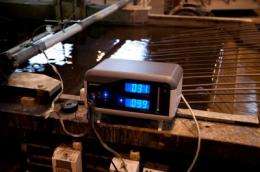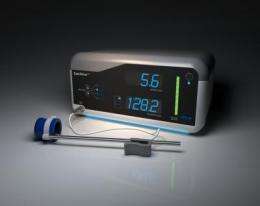NPL unveils quantitative means of monitoring ultrasonic cleaning systems

Ultrasonic Cleaning Systems are widely used in healthcare applications during the sterilization of surgical instruments, and in many manufacturing and process industries. They work by passing a high frequency sound wave through a liquid detergent to create thousands of small bubbles. The sound waves then makes the bubbles implode with such force, that the impacts remove contaminant particles from submerged materials.
The current NHS-recommended technique to measure the performance of ultrasonic cleaning systems uses aluminium foil, which is eroded and punctured by the imploding bubbles. This is an unreliable process to apply and can contaminate the vessel cleaning fluid, adding unnecessary costs.
The new NPL CaviMeter™ provides a quick and simple to use measurement solution for cleaning systems, and so is a new and improved method of quality assurance. It consists of a sensor connected by a thin flexible cable to a portable monitor and display unit. The sensor is shielded in a special rubber material designed to protect it, and crucially, providing it with spatial resolution of a few millimeters.

By monitoring the acoustic signals generated when the clouds of bubbles implode, the CaviMeter™ identifies how much cavitation is taking place at a given location, allowing 'hot-spots' and 'cold-spots' in cleaning systems to be identified. Manufacturers can use this information for fine-tuning equipment to produce the ideal quantity and distribution of cleaning action. This approach helps ensure that only the required energy is used, reducing costs and environmental impact.
Mark Hodnett, a Senior Research Scientist at NPL, said: "Until now, there have been no quantitative methods for identifying how much cavitation takes place at different locations in a cleaning system, and therefore no way to ensure that the cleaning process is totally effective. NPL's CaviMeter™ and sensor can now provide this capability, for both users and manufacturers of cleaning systems. It is the first of its kind for acoustically mapping cavitation produced by ultrasonic cleaning and processing systems used in healthcare and manufacturing industries."
The CaviMeter™ supports the manufacture and development of ultrasonic baths, and also allows healthcare organisations to make informed and cost-effective purchasing decisions for cleaning systems. Once a system is chosen, the CaviMeter™ can be used regularly to test the efficacy of its cleaning performance, even when using different detergents and surfactants (wetting agents that lower the surface tension of a liquid).
The CaviMeter™ was designed in response to a longstanding user need. The novel spatially-sensitive cavitation sensor it uses was conceived and developed under Strategic Research at NPL, with the accompanying electronics supported by the Measurement for Innovators programme. It is a great example of how products delivering real impact to end-users can be developed through the National Measurement System (NMS).
A further £2.5 million is now being invested by the NMS and NPL into ultrasound, which includes carrying out research into microbubbles - whereby the bubbles themselves can be used as sensors.
Provided by National Physical Laboratory

















